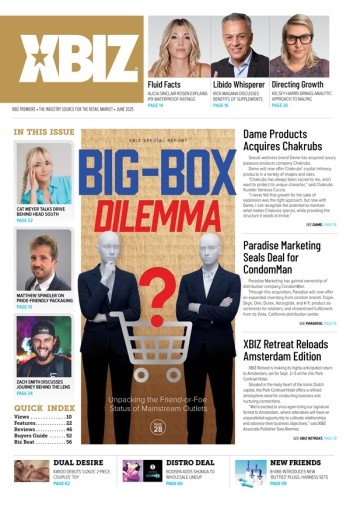I usually write about how to improve your business and the balance of your life from my experiences at JuicyAds. This month in celebration of the annual traffic Issue, I am writing about what I’m actually an expert at — buying and selling advertising.
We are working hard this year at building a better ad network, not just a bigger one. Part of that is making sure our advertisers are doing everything they can to succeed, and stopping them from making the big mistakes we see from time to time. Here are a few of them.
Develop attractive, fresh banners and keep changing them often for best results. Ads get stale surprisingly fast.
Killing earnings potential with a small budget
Everyone has different bankrolls and risk tolerances, and that normally determines the test spend on an advertising network. The biggest mistake here isn’t spending too much, but spending too little to be successful. In my 15 years as an affiliate it sometimes took me weeks for an offer to become profitable or to really take off. Today’s buyers can get impatient and pull the plug too early. I’m horrified to say I have seen advertisers demand refunds after spending less than $1 and not making a sale. Others change gears after just $25 on offers that pay out $35 to $55 a signup. That just doesn’t make sense, so make sure to give your offers a real shot before calling it quits.
Leaving a campaign on “auto pilot”
An ignored campaign is a campaign that will fly into a mountain and burst into flames. Always pay attention to how much you are spending and where you are spending it. You don’t need to watch your campaign every hour of every day, but make sure you are checking in frequently. Always remove unproductive, non-converting, or completely unprofitable sources. Nearly every campaign can be made profitable with optimization.
Failure to properly optimize
There are many optimization options available today including basics such as geo-targeting by country, niche targeting by content, and simply blocking bad sources or white-listing traffic sources that work for you. With the rise of mobile there have been many additional targeting options introduced to the market.
We recently rolled out new great targeting options here at JuicyAds including Wi-Fi/carrier targeting (to target only devices on a mobile carrier versus connected by Wi-Fi connection), and device targeting (to target only specific devices like an iPad or Samsung Galaxy). Anyone can use these options to break down traffic so that you’re only buying the most specific traffic and likely to profit. Failure to optimize at all is a big mistake, but “micro-targeting” can be hurtful too, choking off profitable traffic. If you don’t buy it, someone else will! Do you want to make those profits, or your competitors? There are some buyers who have a specific product catered to a very specific market and that’s great! Another strategy is to layer multiple campaigns to take larger chunks of traffic, and bid high on only the most premium targeting or micro-targeting.
Not testing a variety of banners and ads
One of the biggest problems we run into here at The Sexy Advertising Network, are ads that just aren’t very sexy. People sometimes purchase ads and then are disappointed with the results due to their choice of ad images. Instead of taking the time to split-test different images, text or landing pages to get better results (see my article in the April edition of XBIZ World), inexperienced buyers will often start blaming the publishers for “bad traffic.” Different ads will attract different types of people. Put up a “player button,” and you’re going to get a lot of clicks and probably none of them are going to convert for your company’s new sexy toy. On the other hand, put up a badly stretched, low-resolution image of a sexy chick and you’re going to get low clicks, period. Develop attractive, fresh banners and keep changing them often for best results. Ads get stale surprisingly fast.
Choosing the wrong advertising type for your campaign
We offer both CPM “per impression” ads and CPC “per click” ads. Some networks don’t even give you a choice, but we do because it makes more sense to provide a choice. If you are looking for volume traffic from a high volume of clicks CPM is definitely the way to go.
You will pay per impression (not per click) and it will keep that uber sexy ad from costing you a fortune. For those targeting sales for specific products who want good conversion ratios, it’s usually best to stick with paying per click.
You can put up good converting ads and only pay for performance when someone actually clicks. Nobody wants to pay for an “impression” where your banner is at the very bottom of the page and you get charged when its not even viewed or clicked, right?
Promoting to the wrong audience or not knowing your product
You wouldn’t try to sell a Big Boob paysite membership on a gay website, or place Granny content on a teen website, but people inappropriately target campaigns from time to time. Make sure you are only targeting niches and countries that are relevant to your offer. I recently had a client receive thousands of clicks but not a single conversion. The reason was they had an English-speaking product and required a credit card, but were targeting China and other countries that were foreign and didn’t traditionally have credit cards.
One of our dedicated account managers stepped in and corrected the campaign upon request even though it was a smaller client, we are here to help! Another tip — never promote your product as free unless it actually is. People hate being lied to and you will chase away people that actually are interested in paying.
Bidding too low
Not all traffic is created equal and the best is always going to be “at the top.” Bidding low to start will actually hurt your chances at conversion on most ad networks because you will only receive the lowest quality or traffic that hasn’t already been cherry-picked. I recommend bidding near the top to get a real sample of everything there is to offer, and then reducing if necessary and optimizing as time goes on.
Traffic is the lifeblood of the industry and there are lots of other secrets to buying and selling traffic that I will share in the coming months of “Business and The Blonde” to make the most of your advertising spend.
Juicy Jay is CEO and founder of JuicyAds.com. Follow Jay and JuicyAds via Twitter@juicyads.




